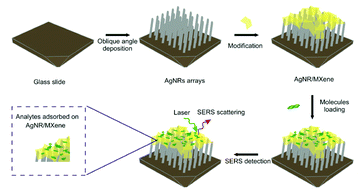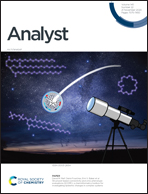Two-dimensional MXene modified AgNRs as a surface-enhanced Raman scattering substrate for sensitive determination of polychlorinated biphenyls†
Abstract
Ultrathin two-dimensional MXene nanosheets were decorated on the surface of silver nanorods (AgNRs) through a facile modification strategy to prepare highly sensitive and reproducible SERS substrates (AgNR/MXene substrate). The MXene nanosheets could suppress the oxidation of the silver nanorods, which endows the substrate with good stability and reproducibility. Due to the strong interaction between AgNR/MXene and the analytes, the substrate also exhibited high SERS performance with the limit of detection (LOD) of crystal violet (CV) as low as 2.48 × 10−11 M. In particular, the AgNR/MXene substrate enabled on-site determination of 3,3′,4,4′-tetrachlorobiphenyl (PCB-77) and 4-chlorobiphenyl (PCB-3) and the LODs were low at 2.43 × 10−10 and 2.14 × 10−9 M, respectively. In addition, the AgNR/MXene substrate could be used for the detection of single-component and multi-component PCBs in real soil samples with good recovery percentages (90.3% and 91.6% for PCB-3 and PCB-77 in single-component format, 108.1% and 106.5% for PCB-3 and PCB-77 in multi-component format). The AgNR/MXene substrate combines the synergistic properties of both AgNRs and MXene, showing great potential in simultaneous SERS detection of multiple pollutants at the point of need.



 Please wait while we load your content...
Please wait while we load your content...